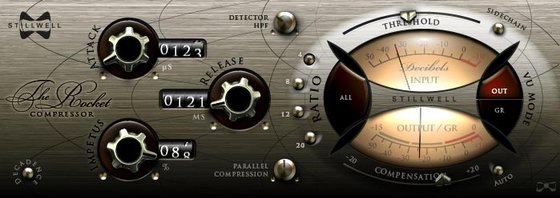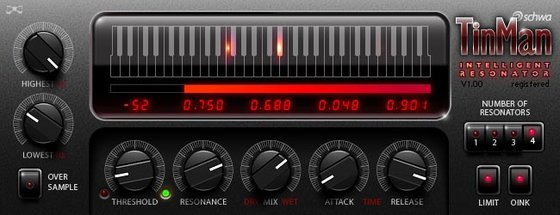Stillwell Audio has released The Rocket, a compressor effect, and TinMan by Schwa, a resonant filter effect.
From the product page:
The Rocket is a character audio compressor, singular in its extraordinary speed, responding in mere microseconds to variations in program level. Being in the order of several thousand times faster than most ordinary compressors, we respectfully submit that The Rocket kicks like a mf.
The Rocket features
- Attack (5 µs–2 ms) – At higher settings some percussive attack will be heard. Set low, your drums will know your wrath. And yes, that says microseconds!
- Release (1 ms–1 s) – Use a longer setting to make your audio pump musically (let the GR meter be your guide.) Lower settings will radically increase room tone, and the aggression of low frequencies.
- Impetus – For the application of even- and oddorder harmonic distortion to the compressed signal.
- Decadence – Raises the internal sample rate to reduce aliasing artefacts.
- Detector HPF – High-pass filters the level detector to restrain the pumping of bass-heavy material.
- Parallel Compression – Mixes the dry signal,(untouched by the attentions of compression, compensation or impetus) with the effected signal for the easy application of the so-called ‘New York Compression’ technique.
- Ratio (4:1. 8:1, 12:1, 20:1, all) – The special and characteristic ‘All’ mode results in a high variable ratio that will work wonders on your drum bus.
- Threshold – Peak level at which compression will be triggered.
- Sidechain – switches The Rocket’s detection circuit to inputs 3&4, if your host allows, so one signal may be compressed by another.
- VU mode – Lower VU meter shows Output level (out) or Gain Reduction (GR).
- Compensation – Applies a make-up gain to compensate for signal level loss due to compression.
- Auto – Automatically apply an additional compensating makeup gain based on the current ratio and threshold settings.
Schwa TinMan
TinMan is an auto-peaking resonant filter with multiple pitch detection and individually triggered attack/decay envelopes. In other words, it listens to your audio and makes matching spooky wooo-eeee-oooo effects.
From the product page:
TinMan uses a new polyphonic pitch detection algorithm to isolate and rank the strongest pitches in the input audio. For each detected pitch, a separate resonant filter, or resonator, is peak-matched to that exact pitch (even if it’s off-key), and an attack envelope is triggered. If a pitch slides, the resonator’s resonant peak will continue to track it. If a pitch ends, the resonator will release until fully quiet.
TinMan usage suggestions
- Spookiness – If you’re doing a sci-fi soundtrack try feeding something, anything, into TinMan and turn the wet mix up full. My God ! It’s made of people!
- Movement – Apply liberally to boring synths, bland string washes and tedious reverbs to add some interest and activity.
- Guitars – From giving arpeggios some flourish to fully-wet synth effects, TinMan loves guitars.
- Backing Vocals – Everyone knows that bass players can’t sing. But sometimes you just have to use what you’ve got, and Tin Man can even turn it into something that sounds like music.
- Percussion – Set the time controls fast, the threshold high, and turn off oink. Apply to drums and bass for a whole host of percussive effects and special effects..
- Enhancement – With ‘Oink’ disengaged, a low threshold and the freqency bar set really high, TinMan can add some sparkly top.
Check the manual (.pdf) for details on TinMan.
The Rocket and Schwa TinMan are available for $50 USD each (or $25 USD for a Reaper-only, personal use license). Fully functional evaluation versions are available for download.
Visit Stillwell Audio for more information and audio demos.




